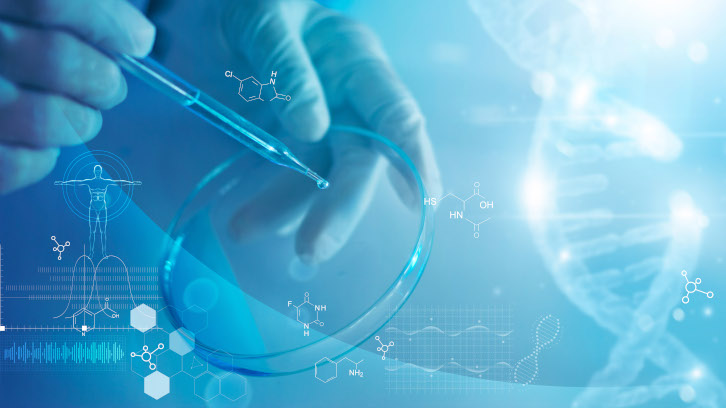Divalent cations: ions for 21st century nanomedicine

The correct functioning of the human body depends, among other factors, on the adequate concentration of divalent cations, elements with a double positive charge on their surface capable of interacting with different molecules at the same time. These ions have been seen to act like glue by exhibiting great versatility in interactions with proteins to form more complex ones. In this article, the Nanobiotechnology Group of the Institute of Biotechnology and Biomedicine (IBB) presents the development of a technology that takes advantage of this ability to create biomaterials, which could be used in cancer nanomedicine and also in regenerative medicine.
Our atmosphere is delineated by an 98 % of oxygen and nitrogen, being indispensable gases for life in Earth. While being essential, those are insufficient, as a large list of additional ionic elements (electrically charged), present fundamental roles in biological systems. Among them, a particular group outstands, named Divalent Cations, which present chemical peculiarities that allow them to be extremely important in our human systems. These ions are extremely versatile, as they expose electric charges on their surface, enabling the interaction with several organic molecules simultaneously.
Because of that, we found them interacting with a plethora of different proteins, as well as DNA, RNA and other organic cell components. Thus, the adequate functioning of our neuromuscular, digestive, hormonal, renal, metabolic, and cardiovascular systems depend on their normal homeostatic concentrations. Alterations of those concentrations may produce huge toxicological effects in the organism. Amongst all their functions, divalent cations are involved specially in cellular protein-protein interactions (processes in which new soluble and complex structures are formed in the nanometric scale from single protein blocks) and functional aggregates (processes in which new insoluble and complex structures are formed in a controlled way).
The scientific community is currently taking advantage of these natural capabilities of divalent cations to create new materials, mostly based on proteins, with many biomedical applications. All these new methodologies contemplate the usage of divalent cations as gluing protein to protein agents, in order to form new structures. Even more, researchers have found that the addition of a simple histidine tag (6 consecutive histidines, also known as purification tag) in the protein sequence, increases exponentially the efficacy of the process. This fact may be produced thanks to the high affinity of a nitrogen atom in the histidine structure towards the superficial charge of divalent cations at physiological pH. In principle, two protein can be linked for each added divalent cation. In this regard, changes in the divalent cation-protein proportions may promote changes in the complexity of the final material. The phenomenon could be reverted by the addition of ethylenediaminetetraacetic acid (EDTA), a kidnaping chemical molecule specific for divalent cations.
Figure 1 Reprinted from original article with permission from Elsevier. Copyright (2020)
Our nanobiotechnology group, attached to the Institute of Biotechnology and Biomedicine (IBB), is pioneer in using this technology and has created a plethora of different functional materials with applicabilities in precision cancer nanomedicine and regenerative medicine, in collaboration with the Centro de Investigaciones Biomédicas en Red (CIBER-BBN) and the Instituto de Investigaciones Biomédicas de Sant Pau.
Finally, and highlighting that these manufacturing methods are promising, simple, versatile, and cheap, the toxicological capacity of divalent cations should be addressed when administered in the human body. Because of that, it is necessary to determine the respective tolerant doses in order to create safe, functional, and biocompatible materials that could make a great impact in the nanomedicine of the 21st century.
Hèctor López-Laguna 1, 2, 3, Julieta Sánchez 1, 2, 4, Ugutz Unzueta 2, 3, 5, Esther Vázquez 1, 2, 3, i Antonio Villaverde 1, 2, 3
Universitat Autònoma de Barcelona.
1 Institut de Biotecnologia i de Biomedicina.
2 Departament de Genètica i de Microbiologia.
3 CIBER de Bioingeniería, Biomateriales y Nanomedicina (CIBER-BBN), Madrid.
4 Instituto de Investigaciones Biológicas y Tecnológicas (IIBYT) (CONICET-Universidad Nacional de Córdoba), ICTA & Cátedra de Química Biológica, Departamento de Química, FCEFyN, X 5016GCA, Córdoba, Argentina.
5 Biomedical Research Institute Sant Pau (IIB-Sant Pau), Hospital de la Santa Creu i Sant Pau, Barcelona.
References
López-Laguna H, Sánchez J, Unzueta U, Mangues R, Vázquez E, Villaverde A. Divalent Cations: A Molecular Glue for Protein Materials. Trends Biochem Sci. 2020 Nov;45(11):992-1003. doi: 10.1016/j.tibs.2020.08.003. Epub 2020 Sep 3. PMID: 32891514.


